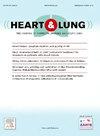Use of BUG-SAFE (Bougie guide safe percutaneous tracheostomy) to prevent airway loss in critically Ill patients: Cohort study
IF 2.6
4区 医学
Q2 CARDIAC & CARDIOVASCULAR SYSTEMS
引用次数: 0
Abstract
Background
The Bougie Guide Safe Percutaneous Tracheostomy (BUG-SAFE) technique is a novel approach designed to reduce airway loss and complications during tracheostomy in ventilated patients.
Methods
We conducted a retrospective cohort study of ICU patients (2020–2023) undergoing tracheostomy with the BUG-SAFE technique to facilitate prolonged weaning from mechanical ventilation.
Results
Of 1286 ICU admissions, 128 patients were included. Complications occurred in 17.2 % (mainly bleeding), and one death (0.7 %) was reported. No cases of hypoxemia or airway loss were observed. Risk of complications was associated with ICU stay, ventilation duration, APACHE II scores, and oxygen debt. BUG-SAFE showed a high sensitivity for detecting complication-related mortality. The technique also reduces aerosolization, enhancing safety for healthcare providers.
Conclusions
BUG-SAFE is a safe, feasible bedside technique with low complication rates. It ensures airway security and minimizes aerosol generation, making it suitable for both patients and healthcare personnel.
使用BUG-SAFE (Bougie引导安全经皮气管造口术)预防危重患者气道丢失:队列研究
Bougie Guide安全经皮气管造口术(BUG-SAFE)技术是一种新颖的方法,旨在减少通气患者气管造口术中的气道损失和并发症。方法对2020-2023年ICU患者进行回顾性队列研究,采用BUG-SAFE技术进行气管切开术以促进机械通气延长脱机。结果1286例ICU入院患者中,纳入128例。并发症发生率为17.2%(主要为出血),死亡1例(0.7%)。无低氧血症或气道丢失病例。并发症风险与ICU住院时间、通气时间、APACHE II评分和氧债相关。BUG-SAFE在检测并发症相关死亡率方面具有很高的敏感性。该技术还减少了雾化,提高了医疗保健提供者的安全性。结论bug - safe是一种安全、可行、并发症发生率低的床边技术。它确保气道安全,最大限度地减少气溶胶的产生,使其适合患者和医护人员。
本文章由计算机程序翻译,如有差异,请以英文原文为准。
求助全文
约1分钟内获得全文
求助全文
来源期刊

Heart & Lung
医学-呼吸系统
CiteScore
4.60
自引率
3.60%
发文量
184
审稿时长
35 days
期刊介绍:
Heart & Lung: The Journal of Cardiopulmonary and Acute Care, the official publication of The American Association of Heart Failure Nurses, presents original, peer-reviewed articles on techniques, advances, investigations, and observations related to the care of patients with acute and critical illness and patients with chronic cardiac or pulmonary disorders.
The Journal''s acute care articles focus on the care of hospitalized patients, including those in the critical and acute care settings. Because most patients who are hospitalized in acute and critical care settings have chronic conditions, we are also interested in the chronically critically ill, the care of patients with chronic cardiopulmonary disorders, their rehabilitation, and disease prevention. The Journal''s heart failure articles focus on all aspects of the care of patients with this condition. Manuscripts that are relevant to populations across the human lifespan are welcome.
 求助内容:
求助内容: 应助结果提醒方式:
应助结果提醒方式:


